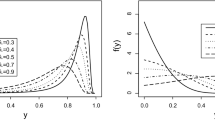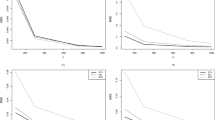Abstract
We propose a new regression model based on the concepts of generalized linear models (GLMs), assuming the beta Weibull distribution. Similar to GLMs, the proposed model is called the generalized beta Weibull linear model (GBWLM). The maximum likelihood estimation of the parameters assuming the Newton–Raphson algorithm is discussed. The local influence methodology regarding three perturbation schemes is developed for the GBWLM. To check the model assumptions, detect atypical observations and verify the goodness of fit of the regression model, residuals based on the quantile function are proposed and a Monte Carlo simulation study is performed to construct simulated envelopes.





Similar content being viewed by others
References
Atkinson AC (1985) Plots, transformations and regressions. Oxford statistical sciences series. Clarendon Press, Oxford
Cook RD (1986) Assessment of local influence (with discussion). J R Stat Soc Ser B 48:133–169
Cox DR, Reid N (1987) Parameter orthogonality and approximate conditional inference. J R Stat Soc Ser B 49:1–39
Cordeiro GM, Nadarajah S, Ortega EMM (2013) General results for the beta Weibull distribution. J Stat Comput Simul 83:1082–1114
da Cruz JN, Ortega EMM, Cordeiro GM (2016) The log-odd log-logistic Weibull regression model: modelling, estimation, influence diagnostics and residual analysis. J Stat Comput Simul 86:1516–1538
Dunn KP, Smyth GK (1996) Randomized quantile residuals. J Comput Gr Stat 5:236–244
Famoye F, Lee C, Olumolade O (2005) The beta-Weibull distribution. J Stat Theory Appl 4:121–136
Hashimoto EM, Cordeiro GM, Ortega EMM (2013) The new Neyman type A beta Weibull model with long-term survivors. Comput Stat 28:933–954
Henningsen A, Toomet O (2011) maxLik: a package for maximum likelihood estimation in R. Comput Stat 26:443–458
Hashimoto EM, Ortega EMM, Cordeiro GM, Cancho VG (2015) A new long-term survival model with interval-censored data. Sankhya B 77:207–239
Ibacache-Pulgar G, Paula GA, Galea M (2014) On influence diagnostics in elliptical multivariate regression models with equicorrelated random errors. Stat Methodol 16:14–31
Lesaffre E, Verbeke G (1998) Local influence in linear mixed models. Biometrics 54:570–582
Nelson WB (2004) Accelerated testing statistical models, test, plans and data analysis. Wiley, Hoboken
Ortega EMM, Cordeiro GM, Hashimoto EM (2011) A log-linear regression model for the beta-Weibull distribution. Commun Stat Simul Comput 40:1206–1235
Ortega EMM, Cordeiro GM, Kattan MW (2012) The negative binomial beta Weibull regression model to predict the cure of prostate cancer. J Appl Stat 39:1191–1210
Ortega EMM, Cordeiro GM, Kattan MW (2013) The log-beta Weibull regression model with application to predict recurrence of prostate cancer. Stat Pap 54:113–132
Ortega EMM, Cordeiro GM, Hashimoto EM, Cooray K (2014) A log-linear regression model for the odd Weibull distribution with censored data. J Appl Stat 41:1859–1880
Ortega EMM, Cordeiro GM, Campelo AK, Kattan MW, Cancho VG (2015) A power series beta Weibull regression model for predicting breast carcinoma. Stat Med 34:1366–1388
Pescim RR, Ortega EMM, Cordeiro GM, Alizadeh M (2016) A new log-location regression model: estimation, influence diagnostics and residual analysis. J Appl Stat 86:1516–1538
Poon W, Poon YS (1999) Conformal normal curvature and assessment of local influence. J R Stat Soc Ser B 61:51–61
Prudente AA, Cordeiro GM (2010) Generalized Weibull linear models. Commun Stat Theory Methods 39:3739–3755
Vanegas LH, Rondón LM, Cordeiro GM (2013) Diagnostic tolls in generalized Weibull linear regression models. J Stat Comput Simul 83:2315–2338
Yiqi B, Russo MC, Cancho VG, Louzada F (2015) Influence diagnostics for the Weibull negative-binomial regression model with cure rate under latent failure causes. J Appl Stat 43:1027–1060
Zeller CB, Lachos VH, Labra FV (2014) Influence diagnostics for Grubbs-s model with asymmetric heavy-tailed distributions. Stat Pap 55:671–690
Acknowledgements
We are very grateful to a referee and an associate editor for helpful comments that considerably improved the paper. We gratefully acknowledge the financial support from CAPES and CNPq Brazil.
Author information
Authors and Affiliations
Corresponding author
Rights and permissions
About this article
Cite this article
Santana, T.V.F., Ortega, E.M.M. & Cordeiro, G.M. Generalized Beta Weibull Linear Model: Estimation, Diagnostic Tools and Residual Analysis. J Stat Theory Pract 13, 16 (2019). https://doi.org/10.1007/s42519-018-0022-7
Published:
DOI: https://doi.org/10.1007/s42519-018-0022-7




